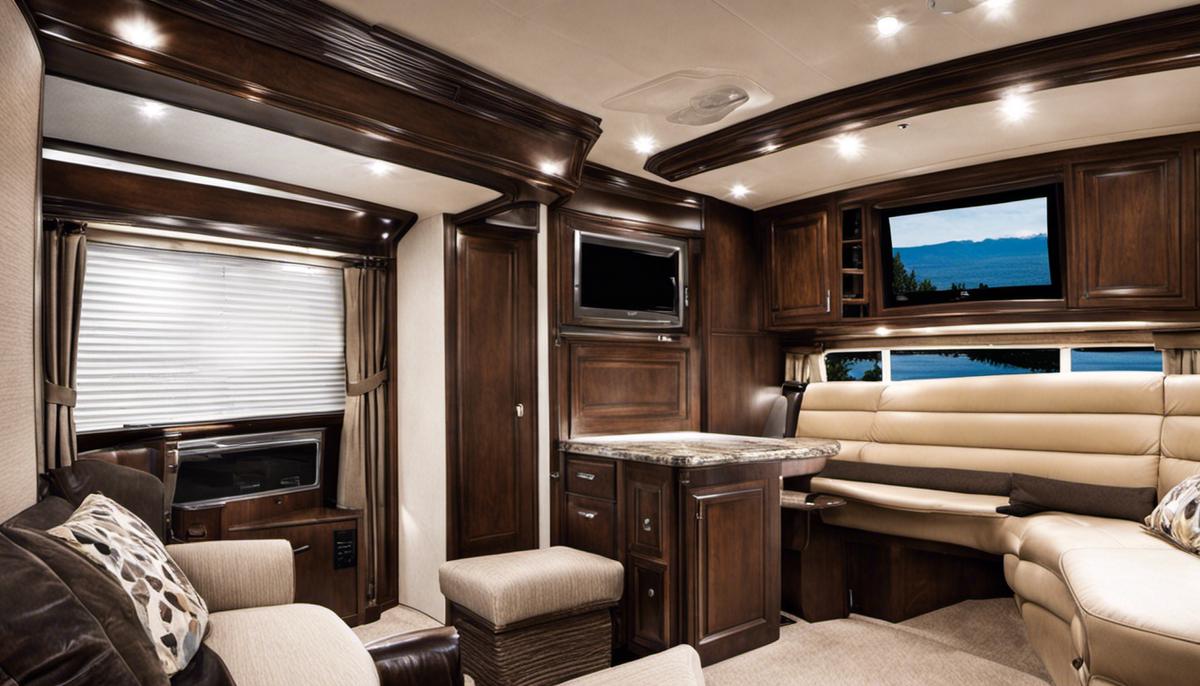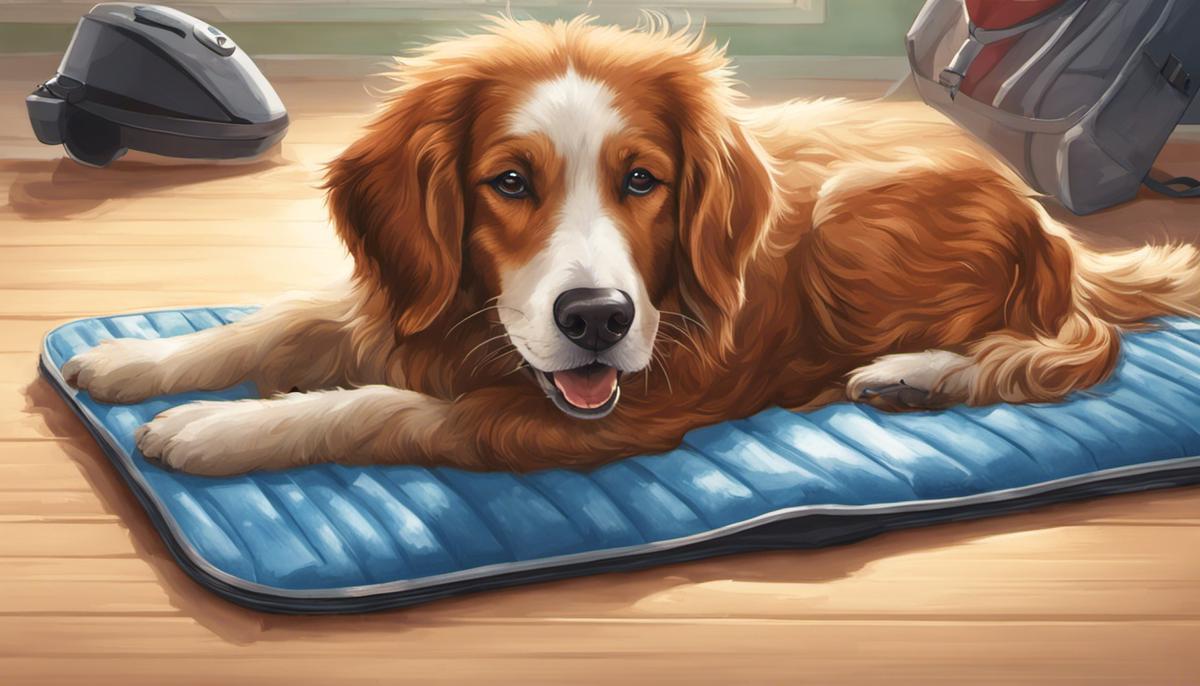
Keeping Your Dog Cool in Your RV: Tips and Tricks
For intrepid adventurers and their canine companions, an RV provides an ideal blend of mobility and comfort. However, ensuring that these mobile homes remain cool and comfortable for our furry friends during the warmer months can present a unique set of challenges. This piece will delve into understanding heat stroke in dogs, a critical condition dog owners ought to recognise. It will explore the nuances of RV ventilation and air conditioning, a crucial element to maintaining a dog-friendly temperature within the vehicle. Additionally, it will investigate a variety of dog-specific cooling solutions, such as cooling mats and vests, alongside the practicality of portable fans. Lastly, it will emphasise the importance of hydration and provide insights into optimal care practices for dogs within an RV environment during hot conditions.
Understanding Heat Stroke in Dogs
Understanding Heat Stroke in Dogs
Heat stroke is a serious health risk to dogs that can occur when the animal is exposed to high temperatures. Symptoms may include heavy panting, dry or bright red gums, thick drool, vomiting, diarrhea, or shaky legs. In severe cases, dogs may collapse, have seizures, or go into a coma.
Potential Consequences of Heat Stroke
Heat stroke can have serious adverse effects on dogs. Prolonged exposure to high temperatures can lead to multiple organ dysfunctions including kidney failure, heart system disorder, and neurological problems. In some cases, heat stroke can lead to death. It is essential to prevent heat stroke in dogs due to its potential severe consequences.
Treating Heat Stroke in Dogs
If you suspect your dog is suffering from heat stroke, immediate action is necessary. One of the first steps is to remove the dog from the hot environment. Try to cool them down gradually; sudden cooling can lead to other complications.
Wrap them in cool, but not cold, wet towels, focusing on the neck and head area. Avoid covering the eyes, nose or mouth. Provide your dog with cool water, but don’t force them to drink.
After initial cooling, take your dog to the vet immediately, even if they appear to be better. Heat strokes can cause unseen problems, like kidney failure, which need to be caught early on.
Preventative Measures in Hot Environments such as RVs
To keep your dog cool in a RV, there are several steps you can take. Firstly, never leave your dog alone inside for long periods, as temperatures can rapidly increase, especially in summer. If possible, use air conditioning to help keep the temperature inside the RV stable.
Keep the shades down or use blinds to reduce the amount of sun getting in. Always have plenty of fresh, cool water accessible for your dog. Avoid heavy exercising during heatwaves when inside the RV.
Consider using a cooling mat or bed for your dog to rest on, or wet towels on the floor for them to lie on. Regularly check on your dog and be aware of their comfort level.
These precautions will help safeguard your dog from heat stroke and ensure they remain comfortable – and most importantly, safe – when traveling with you in your RV.

RV Ventilation and Air Conditioning
Understanding RV Ventilation and Air Conditioning Systems
A recreational vehicle (RV) typically incorporates ventilation and air conditioning systems to manage and maintain an optimal temperature inside. The central air conditioning system in an RV is generally roof-mounted and ducted throughout the vehicle, providing evenly distributed cool air. The vents are your primary tool for circulation, and in more establish models, you might see a combination of floor, ceiling, and dashboard vents.
For beginners, it is important to note that while the air conditioning system directly controls temperature, the ventilation system can indirectly influence temperature by controlling airflow. This combination is key to ensuring the maximum comfort of your pet dog within the RV, especially in particularly hot periods of travel.
Selecting Effective and Efficient RV Air Conditioning Systems and Ventilation
When selecting an air conditioning system for your RV, primarily consider the size, power, and efficiency of the system. The RV’s size will determine the amount of BTUs (British Thermal Units) required to cool down the interior. For instance, smaller RV’s like campervans generally require between 5,000 to 7,000 BTUs, while large motorhomes may require up to 15,000 BTUs. Energy efficiency ratings should also be a crucial part of your consideration to reduce power consumption and battery drain.
The ventilation system should be adequate for the size of the RV and also capable of exhausting hot air and drawing in cooler air when necessary. This is especially important if you travel with pets or cook inside the RV often, as both introduce considerable additional heat sources.
Installing Ventilation and Cooling Systems
The installation process for these systems varies greatly depending on the make and model of the RV, as well as the chosen type and model of air conditioning and ventilation system. Comprehensive owner manuals and installation instruction guides typically accompany new systems. These remain paramount essentials during the installation process.
For both ventilation and air conditioning systems, thorough preparation of the installation space is required. Usually, this involves ensuring a clean, obstruction-free space for the units, which is structurally solid and capable of withstanding the weight. Accurate measurements and precutting where necessary is also crucial.
Despite appearing straightforward, installing these units is no novices’ task, especially given the electrical and structural elements involved. Therefore, hiring professional help is highly recommended. A professional installer will have the necessary experience, tools, and knowledge to complete the task efficiently and safely.
Using these Systems to Cool the RV for Your Dog
Managing and maintaining an optimal temperature for your dog is key, and the recommended temperature is generally between 20°C to 26°C. To ensure the best comfort for your dog, don’t only rely on the air conditioning system. Use a combination of natural ventilation — opening windows and rooftop vents — and artificial cooling — running the air conditioning system as needed. Familiarise yourself with the different controls on your AC unit to utilise them effectively; most will allow you to set the desired temperature, and once reached, automatically maintain it.
Remember to always keep the air circulating, especially in smaller recreational vehicles. This can be done by using fans or having windows open, if safe to do so, to help distribute the cool air. Never leave your dog alone in the RV for long periods in extreme temperatures, even if the air conditioning is on. This can lead to dangerous heat or cold spikes that can endanger your pet. Regularly checking in on your dog, and providing plenty of fresh water, helps in keeping your dog cool and comfortable while travelling.

Dog-Friendly Cooling Solutions
Understanding Dog-Friendly Cooling Solutions
When it comes to keeping your canine companions cool during a trip in a RV, there are several effective dog-friendly solutions to consider. These include cooling mats, cooling vests, and portable fans, each designed to provide a helpful means of combating heat, especially during summer trips.
Cooling Mats: Comfort in the Heat
Cooling mats for dogs take advantage of gel technology or water to absorb heat from your dog’s body. These mats are typically made from durable materials that are puncture resistant. The cooling gel inside the mat activates when your dog lies on it, offering instant relief from the heat. Cooling mats are convenient to use and transport, and require no electricity, making them a great choice for RV travel. The benefits include: keeping your dog at a comfortable temperature, protecting against overheating and helping to ease heat-related conditions such as hip dysplasia and arthritis.
Cooling Vests: Dressed for Coolness
Cooling vests for dogs work similarly, except they are worn on the body. These vests are usually made of a special fabric that retains water when soaked, yet feels largely dry to the touch. The vest will slowly evaporate the water, which draws heat away from your dog, creating a cooling effect. Cooling vests can be an extremely beneficial cooling solution for dogs, particularly for those breeds that are prone to overheating or those with thick fur. It can keep your dog cool for several hours, depending on the surrounding temperature and humidity.
Portable Fans: A Breath of Fresh Air
Portable fans can also be a good solution to keep your dog cool in a RV. Look for fans that are silent, powerful, and ideally rechargeable. Position the fan so that it circulates air around your RV, but does not necessarily blow directly on your dog which might make him uncomfortable. Benefits of a portable fan include improving ventilation in your RV, helping to prevent heat stroke in dogs, and even aiding in the distribution of cool air from other sources like an air conditioner or an open window.
Choosing and Using these Cooling Solutions
When it comes to choosing the right solution for your dog, consider their specific needs and characteristics. Breeds with thick fur, elderly dogs, puppies, or dogs with health issues may benefit more from certain solutions than others.
For cooling mats and vests, make sure you choose the correct size that fits your dog appropriately. Keep in mind that, like a pillow or mattress, cooling mats will eventually lose their cooling abilities and need to be replaced.
In the case of portable fans, consider factors like size, noise level, power source, and safety, particularly if your dog is likely to be curious about it.
Always observe your dog during the initial use of a new cooling solution to see how they respond and ensure their comfort. With a bit of knowledge and preparation, you can help your four-legged friend have a cool, comfortable journey in your RV.

Dog Hydration and Care in Hot Conditions
Understanding Dehydration in Dogs
Dehydration in dogs can be a serious issue, especially in hotter climates or confined spaces such as an RV. Signs of dehydration include lethargy, sunken eyes, panting, loss of appetite, and dry nose and gums. If the skin loses elasticity and does not spring back when gently pinched, this can also be a symptom. It is crucial to recognise these signs and take action promptly.
Hydrating Drinks for Dogs
Water is the best hydrating drink for dogs. It should be made easily accessible, with plenty of fresh, cool water available at all times. Change the water frequently to ensure it remains fresh and rehydrating. In case of severe dehydration, you could provide an electrolyte solution suitable for pets, but seek veterinary advice before doing so.
Hydrating Foods for Dogs
Certain foods can also help keep your dog hydrated. Many fruits and vegetables, like cucumber, watermelon, and strawberries, contain a high percentage of water and can be a great addition to a dog’s diet – in moderation and always confirming they are safe for dogs, of course. Do remember that these are not a substitute for water but can serve as a useful supplement during hot weather.
Keeping Dogs Hydrated in an RV
There are a few strategies you can implement to keep your dog cool and hydrated in an RV. Firstly, ensure there is always a shaded area where your dog can escape the heat. Second, keep the RV well-ventilated by opening windows or running the air conditioning, if available.
For water accessibility, consider portable water bowls or water bottles specifically designed for dogs, able to store and provide water when your dog needs it. It could be a good idea to have a few of these filled up and distributed around the RV so your dog can always find a drink.
Frozen treats are also a good idea for the RV. Not only can they help to cool your dog down, but they’ll also provide some hydration. You can freeze plain water, pet-friendly broth, or make treats with hydrating fruits or veggies.
Lastly, never leave your dog alone in a hot RV for extended periods. If you are unable to take your dog with you, make sure someone else is available to check up on them regularly.
By implementing these measures, you can ensure your beloved pet remains cool, hydrated, and healthy while travelling in your RV.

Knowing how to keep our four-legged friends cool in an RV is more than just a matter of comfort—it directly pertains to their health and wellbeing. From detecting symptoms of heat stroke and understanding your RV’s ventilation system, to implementing dog-friendly cooling methods and ensuring adequate hydration, each strategy forms a vital part of a comprehensive approach to your dog’s safety. With the detailed knowledge gained here, you can confidently embark on your RV adventures, ensuring enjoyable and comfortable travel experiences for you and your dog, regardless of the weather. Remember, a well-cared-for dog is a happy dog, and a happy dog makes for an even happier journey.
